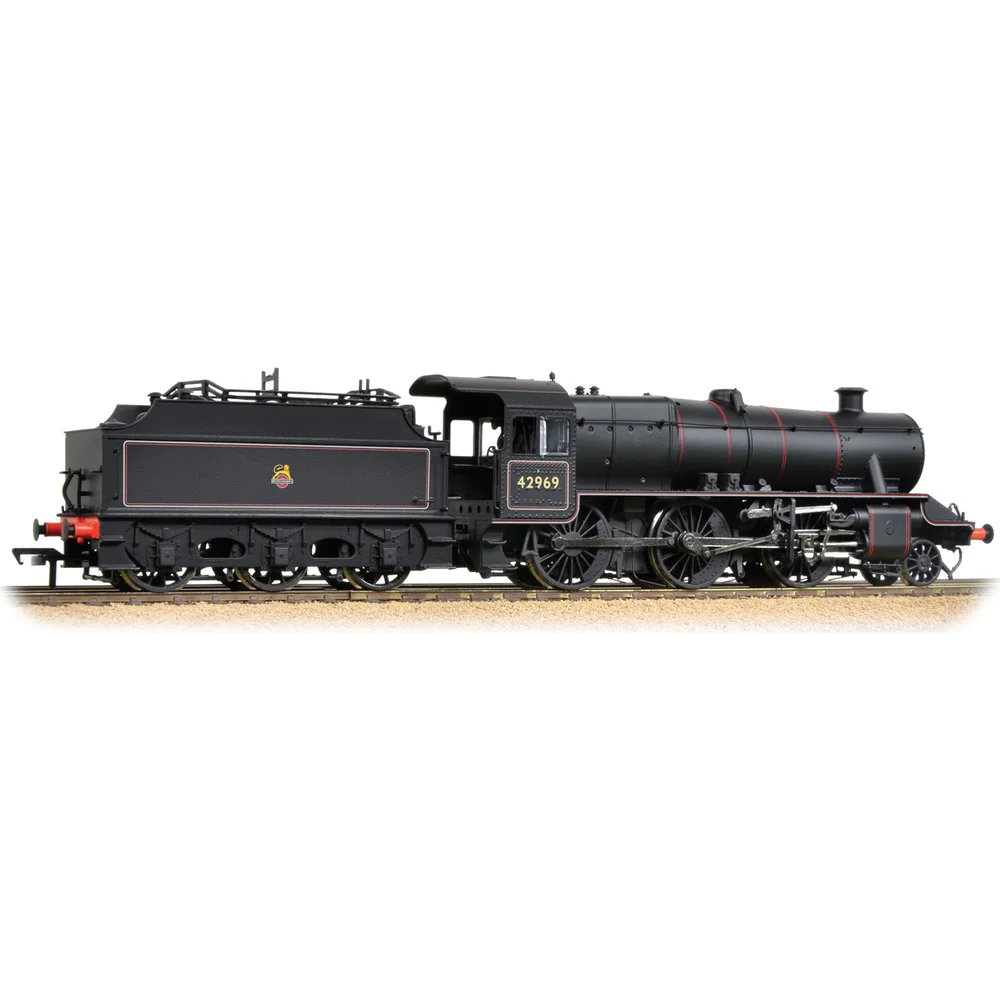Bachmann 31-691
London, Midland & Scottish Railway Stanier Mogul 42969 British Railways Lined Black with Early Emblem
Tooling
The Bachmann Branchline LMS Stanier Mogul was first announced in 2013 and entered production around 2016–2017. This model represents the LMS Class 5 2-6-0 mixed traffic steam locomotive designed by William Stanier, with forty prototypes built between 1933 and 1934. The tooling was developed to fill a notable gap in LMS motive power offerings and was welcomed by enthusiasts, especially those familiar with preserved locomotive No. 42968.
Tooling Features
- Scale: OO gauge (1:76)
- Construction: Combination of plastic and metal components
- Detailing: Separately fitted handrails, lamp irons, turned brass safety valves and whistle, detailed cab interior, footplate, and fallplate. Pipework and bufferbeam details are pre-fitted.
- Couplings: NEM pockets with tension lock couplings
- Tender: Permanently coupled Fowler-style tender with pick-ups and detailing including coal rails and brake gear
Mechanical & Electrical
- Motor: Can motor located in the locomotive
- Drive: Loco-driven with pickups on driving wheels
- Minimum Radius: Designed to run on 2nd radius curves (438mm)
- Weighting: Moderate weight for good traction; performance noted as smooth and reliable
- Lighting: No factory-fitted lighting
DCC Capability
- Socket: 21-pin DCC ready
- Sound: No factory-fitted speaker; space not provided for sound installation
Liveries Produced
- LMS Lined Black No. 2965 (Era 3)
- BR Lined Black Early Emblem No. 42969 (Era 4)
- BR Lined Black Late Crest No. 42968 (Preserved) (Era 5/9)
Reception & Commentary
The Stanier Mogul tooling was well received for its attention to detail and smooth running performance. Reviewers praised the model’s finish, separately fitted parts, and accurate representation of the prototype. The model was featured in several video reviews, including Sam’sTrains and Class47Peter, both of which highlighted its historical significance and mechanical reliability.
Social media and forums such as RMweb noted the long anticipation for the model and its popularity among LMS and Severn Valley Railway enthusiasts. The preserved No. 42968, often seen on the SVR, added to the appeal of the preserved livery version.
Additional Notes
- Accessory packs included optional static display parts such as cab doors and brake pipes
- Instruction sheets provided detailed guidance on lubrication and maintenance
The Bachmann Stanier Mogul tooling remains a respected addition to the LMS model range, offering a blend of historical accuracy and reliable performance for OO gauge modellers.
Class & Prototype
- Class: London, Midland & Scottish Railway Stanier Mogul
- Traction: Steam
- Built: 1933-1934
- Total Built: 40
No prototype found.
Operator & Livery
- Operator: British Railways
- Livery: Lined Black with Early Emblem
British Railways transformed Britain's fragmented rail network into a unified national system following nationalisation on 1st January 1948. Created from the "Big Four" companies under the Transport Act 1947, BR operated most of Great Britain's railways until rebranding as British Rail in 1965, managing over 20,000 route miles and inheriting nearly 20,000 locomotives of diverse designs.
The organisation pioneered standardisation through its revolutionary BR Standard locomotive programme (1951-1960), producing 999 advanced steam engines under Robert Riddles' direction. These included the versatile Britannia Pacifics, mighty 9F freight engines, and mixed-traffic classes that incorporated the best features from all predecessor companies. The 1955 Modernisation Plan accelerated diesel and electric traction development, creating fascinating mixed-traction operations.
Notable achievements included establishing unified locomotive classification systems, introducing distinctive corporate liveries, and managing the complex transition from steam to modern traction. BR's six regional structure preserved operational diversity whilst enabling standardisation of practices, signalling, and rolling stock that had eluded private enterprise for over a century.
The BR era represents steam traction's final flowering alongside emerging diesel technology, creating unparalleled locomotive variety. Today, this heritage remains highly popular with railway enthusiasts through extensive preserved fleets, heritage railway operations, and comprehensive model ranges from manufacturers like Hornby, Bachmann, and Dapol, making BR subjects essential for authentic post-war British railway modelling across all scales.
British Railways' lined black livery was designated for mixed-traffic and secondary passenger locomotives from 1949, following pure LNWR style with black base colour and elaborate red, cream (off-white), and grey lining patterns. The lining specification comprised 5/8" grey, 1/8" cream, 1½" black, and ¼" red bands, with the layout consistent with LNWR practice including deep and shallow valances lined along bottom edges only, unlike green engines. The first lined black engines appeared in August 1948 when Hall 5954 appeared so painted, becoming one of the first to carry the "Lion and Wheel" emblem around the same time.
A wide range of engines was eligible for this livery, from powerful V2s and Counties down to tiny Southern Terriers, encompassing County, Hall, Grange, Manor, Saint, Prairie tanks, and numerous pre-grouping designs of varied shapes and sizes. This created many variations and interpretation problems due to the diverse locomotive types involved, with regional differences in splasher lining treatment—the Eastern Region used red-only splasher lining, whilst the Southern Region evolved from inset to edge lining styles. The emblem was positioned centrally on tender sides above the middle axle box, with the Western Region favouring larger sizes on tenders and bigger tank engines. An interesting period detail saw number plates routinely painted red from late 1949 to early 1952, adding colour contrast to the otherwise black scheme. This livery represented BR's commitment to standardising mixed-traffic operations whilst maintaining the decorative traditions that distinguished passenger-rated locomotives from plain freight engines.
